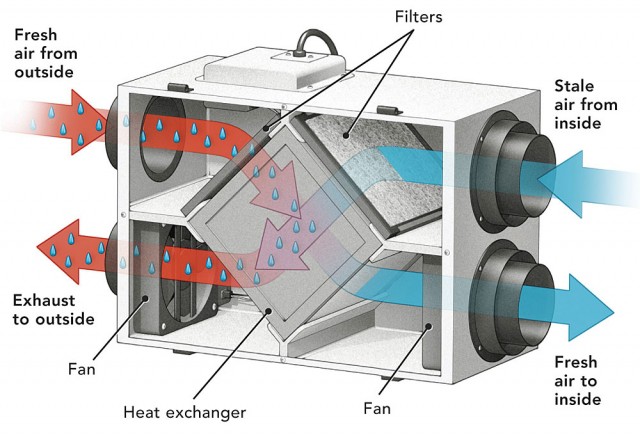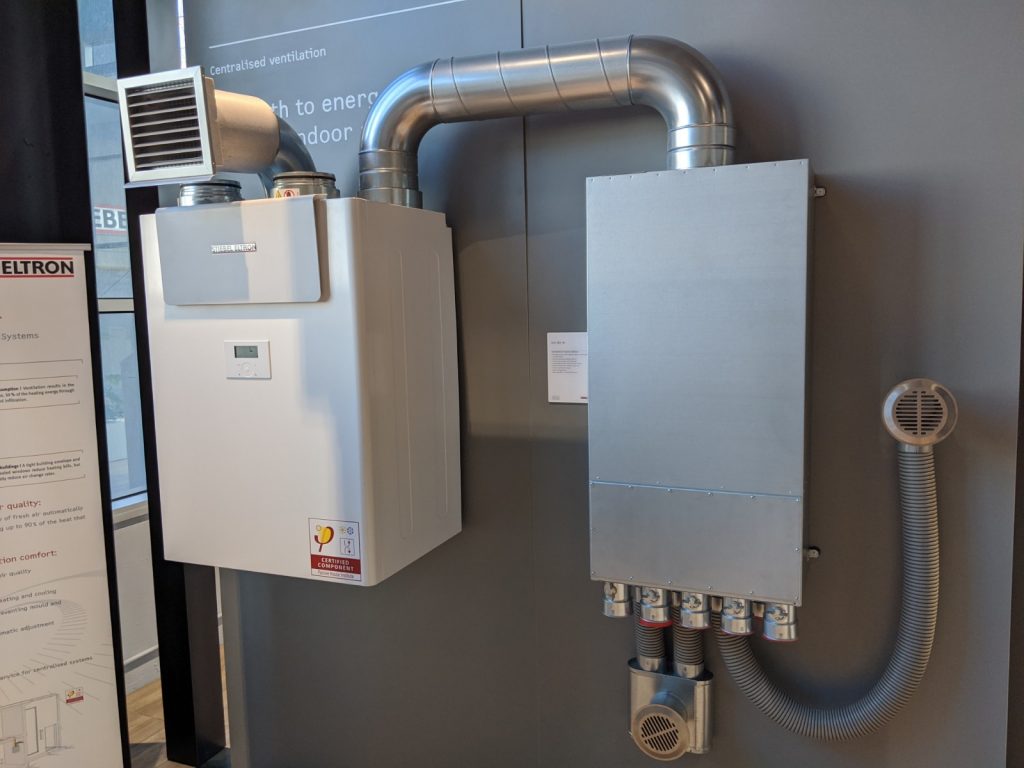Introducing the Trick Conveniences and Uses of Heat Recovery Ventilation in Sustainable Style
Heat Recovery Ventilation (HRV) systems play a necessary function in lasting style. They help with a continuous exchange of stagnant interior air with fresh outside air, significantly improving interior air high quality. Additionally, HRVs add to energy effectiveness by recovering heat from tired air, which can lower energy expenses. Comprehending the multifaceted benefits and applications of HRVs reveals their importance in contemporary style. What various other advantages do these systems offer in the quest of sustainability?
Understanding Heat Recovery Ventilation Systems
Heat recovery ventilation (HRV) systems are created to boost indoor air high quality while decreasing energy loss. These systems make use of a mechanical air flow method to exchange stagnant interior air with fresh outside air, making certain a continuous supply of tidy air. By catching heat from the exhaust air, HRVs prerequisite inbound air, minimizing the demand on home heating and cooling down systems. This process not only improves thermal comfort but also adds to power performance in domestic and industrial buildings. In addition, HRV systems help manage moisture degrees and lower indoor contaminants, advertising a much healthier living environment. Their tactical implementation is vital for accomplishing lasting design goals, as they offer an equilibrium in between power preservation and passenger well-being.
How HRV Solution Job
While lots of may recognize with air flow systems, recognizing how heat healing ventilation (HRV) systems operate is vital for valuing their benefits. HRV systems function by exchanging stale interior air with fresh outside air while transferring heat in between the 2 streams. This procedure takes place in a warmth exchanger, where warmth from the outward bound air heats the incoming air during chillier months, lessening energy loss. On the other hand, in warmer months, the system can cool incoming air using the cooler outward bound air. HRVs are outfitted with followers to facilitate air movement and filters to get rid of particulates, making certain a continual, well balanced ventilation procedure. This ingenious style not only enhances power effectiveness yet additionally contributes to maintaining a comfy interior atmosphere.
Enhancing Indoor Air Quality
Interior air high quality can significantly impact wellness and health, making efficient ventilation essential in modern-day homes. Heat Recovery Ventilation (HRV) systems play a crucial role in preserving interior air high quality by constantly exchanging stale interior air with fresh outdoor air. This procedure not only lowers airborne toxins but additionally lessens moisture levels, which can cause mold and mildew growth and breathing concerns. HRV systems filter incoming air, eliminating allergens and particulates, consequently offering a healthier living setting. In addition, these systems aid get rid of odors and volatile natural compounds (VOCs) generally found in household products. By making certain a constant circulation of clean air, HRV systems add to a general improved interior environment, advertising convenience and health for residents.
Energy Efficiency and Expense Financial Savings
Energy effectiveness stands out as a considerable benefit of Heat Recovery Ventilation (HRV) systems. By capturing and reusing the warm from tired interior air, HRVs minimize the energy needed for home heating inbound fresh air, causing reduced power consumption. This effectiveness equates into reduced utility bills, using considerable price savings for house owners and businesses alike. Furthermore, HRV systems commonly receive energy efficiency incentives and refunds, additionally boosting their economic allure. Over time, the initial investment in HRV innovation can result in a positive roi with decreased energy expenses. The integration of HRV systems not only promotes lasting design but additionally offers a useful remedy for achieving lasting power financial savings and monetary benefits.
Environmental Advantages of HRV

A wide variety of ecological benefits occurs from the application of Heat Recovery Ventilation (HRV) systems. By efficiently moving heat from exhaust air to inbound fresh air, HRVs substantially lower the power needed for heating and cooling down spaces. This power effectiveness converts to reduce greenhouse gas exhausts, adding to a decrease in the general carbon impact of buildings. Furthermore, HRV systems enhance interior air high quality by constantly circulating fresh air, thereby decreasing the concentration of interior pollutants and irritants. The decrease in energy usage aids in preserving natural sources, making HRVs a necessary component of sustainable style. On the whole, the ecological navigate to this website benefits of HRVs play a vital role in promoting a healthier world and cultivating environmentally friendly building techniques.
Versatile Applications in Modern Architecture
Heat recovery ventilation (HRV) systems are significantly being incorporated into both household and business building projects. In property setups, HRVs enhance interior air top quality while maximizing energy efficiency. At the same time, in commercial spaces, these systems enhance air flow strategies, showing their versatility in modern building applications.
Residential Projects Integration
While contemporary design significantly stresses sustainability, the integration of heat healing air flow systems in property projects has arised as a functional option for improving interior air high quality and power effectiveness. These systems successfully transfer heat from exhaust air to incoming fresh air, lessening power loss and decreasing heating or cooling demands. In brand-new builds and retrofits alike, warm healing ventilation can be flawlessly integrated, offering home owners with a much healthier living environment while decreasing utility costs. Furthermore, with increasing understanding of ecological influences, even more architects and building contractors are acknowledging the long-term advantages of these systems. Therefore, heat recuperation air flow has come to be an essential element of lasting domestic design, showcasing versatility and commitment to green methods.
Business Areas Optimization
As contemporary industrial areas develop to fulfill the demands of sustainability and effectiveness, the implementation of warm recovery ventilation systems becomes an essential approach for enhancing indoor atmospheres. These systems help with the exchange of stale interior air with fresh outside air while recovering heat power, significantly reducing power consumption. This not only improves convenience for passengers but additionally assists in decreasing operational costs. Flexible applications can be observed in workplaces, retail areas, and schools, where air high quality and temperature level control are vital. Furthermore, incorporating warm recovery ventilation straightens with green structure qualifications, even more advertising environmental responsibility. Eventually, taking on such systems in industrial architecture not just contributes to sustainability objectives yet additionally fosters healthier, a lot more effective spaces for individuals.
Incorporating HRV Into Sustainable Design Practices
Integrating warm recuperation ventilation (HRV) systems into lasting design techniques provides considerable advantages in power performance and interior air high quality. By using HRV, designers can develop affordable options that not just reduce power usage however likewise enhance the overall comfort of interior settings. This placement with sustainability goals placements HRV as a crucial element in modern-day building methods.
Energy Effectiveness Enhancement
By integrating heat recuperation air view flow (HRV) systems into sustainable layout techniques, designers and contractors can significantly enhance energy effectiveness in modern-day building and constructions. HRV systems function by catching warm from outward bound stale air and transferring it to inbound fresh air, decreasing the energy required for heating or cooling interior spaces. This procedure not just decreases dependence on typical a/c systems yet additionally lowers overall energy consumption. In addition, HRV systems can assist preserve a consistent indoor temperature, decreasing peak energy demands. By incorporating these systems, structures can attain significant reductions in energy expenses and carbon impacts, straightening with sustainability goals. Inevitably, HRV technology stands for a useful service for boosting energy effectiveness in the constructed environment, advertising even more responsible resource usage.
Indoor Air Top Quality Improvement
Exactly how can heat healing ventilation (HRV) systems add to superior indoor air high quality in modern-day structures? HRV systems efficiently exchange stagnant interior air with fresh exterior air while recovering heat, minimizing temperature changes. This procedure decreases the focus of interior toxins, such as volatile natural compounds (VOCs), allergens, and wetness, which can degrade air quality and impact occupant health. By maintaining suitable humidity degrees and guaranteeing a constant supply of clean air, HRVs aid produce a healthier interior setting. On top of that, these systems can be integrated right into lasting layout techniques, advertising power performance along with enhanced air quality. HRV Heat Recovery Ventilation. HRV modern technology plays a vital function in advancing overall occupant convenience and well-being in modern building styles.
Economical Style Solutions

Frequently Asked Inquiries
What Maintenance Is Needed for Heat Recovery Ventilation Solutions?

Maintenance for warm recovery air flow systems usually includes normal filter replacements, cleansing of heat exchangers, examination of fans and air ducts, and ensuring appropriate water drainage. These jobs assist keep efficiency and extend the system's lifespan gradually.
Can HRV Equipments Be Set Up in Existing Structures?
Heat recovery ventilation systems can certainly be set up in existing structures. HRV Heat Recovery Ventilation. Retrofitting calls for careful planning and evaluation of the structure's layout, making certain compatibility with existing systems while maximizing energy effectiveness and interior air quality
How Do HRV Equipment Influence Noise Levels Inside Your Home?
HRV systems can affect interior sound levels by introducing audio from exterior resources through ventilation. Nonetheless, top notch installments typically include sound-dampening attributes, decreasing noise impact while offering effective air exchange and preserving convenience indoors.
Are There Any Downsides to Using HRV Systems?
The disadvantages of making use of HRV systems consist of prospective high preliminary costs, maintenance challenges, and the opportunity of lowered interior air quality if filters are sporadically changed, which might cause concerns with moisture degrees.
Exactly how Do I Select the Right HRV System for My Requirements?
Choosing the ideal heat healing air flow system includes examining certain needs, such as developing dimension, climate, and energy performance objectives. Furthermore, evaluating system features, installment demands, and maintenance factors to consider is necessary for peak performance and satisfaction.